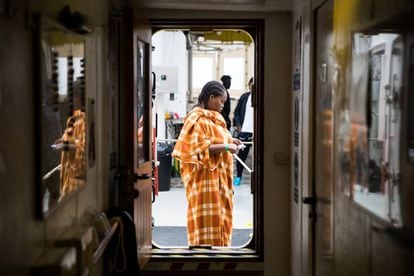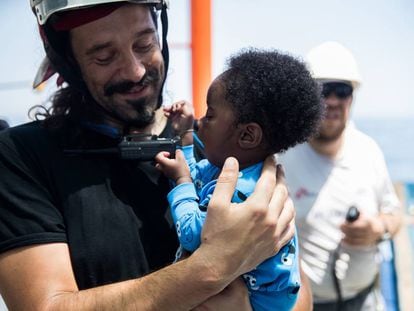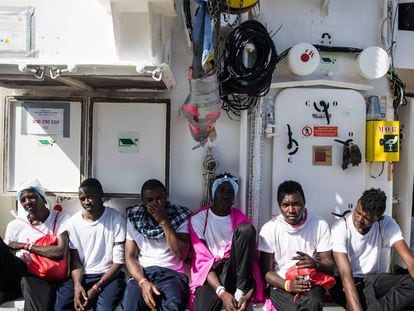The long and arduous journey that the ‘Aquarius’ migrants still face
Conditions have become rougher for the rescue ship as the vessel heads for Valencia, leaving occupants with seasickness and fatigue


The 106 migrants who are currently on board the Aquarius migrant rescue ship were able to recover a little of their dignity yesterday. They were eventually able to clean their teeth and shower – only those who had been taken on board covered in gasoline were able to wash after being rescued. They also received plastic shoes and clean socks. But this did not stop the seasickness.
The water was choppy, with two-meter waves crashing against the deck. The journey to Valencia, which began last Tuesday night and will take four days, is considerably more complicated than the trips the ship typically makes between Libya and the south of Sicily.
They need medical attention and immediate care
Rescue coordinator Nicola Stalla
Most of the people on the Aquarius spent the day trying to combat that seasickness, avoiding sudden movements in an effort to ease the nausea. It’s a very different situation from the last two days, when the ship was at a standstill as it waited instructions. Lassine, 32, and Awa, 30, are among the few who feel okay. “I am much better than I was on the first day, that was terrible,” said the former. He had spent two years in Libya looking for work. Awa had joined him with the idea of going to Europe. Now they are on their way to Spain, a country they know nothing about. A migrant asks what language they speak in Spain and if they will be able to change the language of a cellphone once they buy one.
The rest of the 523 migrants have been transferred to the Dattilo and the Orione, the Italian Coast Guard’s two largest ships. The sick, single women and families have stayed on the Aquarius, but many other women and unaccompanied minors (there are 123 children in total) have been transferred to the naval ships, which have promised to provide medical attention and translators.
Yesterday, the Aquarius was a different ship. There was no more overcrowding, you could walk around the deck without worrying about stepping on someone as they slept. While the weariness persisted, the tension was gone. The mood lifted: they were happy they had a safe port to go to after being rejected by authorities in Italy and Malta.
The journey to Valencia is more complicated than the trips the ship typically makes between Libya and the south of Sicily
But the Mediterranean still has to be crossed. For two days, the Aquarius had been stalled between Italy and Malta in a spot that was as calm as a lake. But the further the vessel advances, the rougher the conditions become. The Gulf of Lion is especially feared. “It is classified as the same level as the North Atlantic,” says rescue coordinator Nicola Stalla. This journey will be very different to the trips the Aquarius usually makes when it began rescuing migrants in the Mediterranean Sea in 2016. The laws regarding rescue missions say that the castaways must be taken to a safe port in the least amount of time possible, meaning migrants are typically kept on board for no more than two days.
The journey to Spain is four days. The not-for-profits in charge of the Aquarius, Sos Mediterranée and Doctors Without Borders (MSF), are concerned about leaving a hot-spot for migrant crossings without three rescue ships. “A ship that has just brought 900 people from Catania [in reference to one of the Italian naval vessels] is sent to Spain, thousands of nautical miles away from where it is most urgently needed by small boats in danger,” says Stalla. The Diciotti was authorized to let 900 migrants disembark in Catania three days after Italy’s new interior minister, Matteo Salvini, closed its ports to the Aquarius.
Stalla says the journey to Spain will be just as difficult for the migrants on the Italian Coast Guard ships. “The people who were rescued are not traveling on a motor boat with lots of food. Just before leaving Libya, many of them were in the concentration camps that are today Libya’s camps. They need medical attention and immediate care.”
In May 2017, the Aquarius had to complete a longer trip than normal with 1,032 people on board – its highest number ever. The ports of Sicily had closed and the ship was forced to sail to Salerno. Now the political decisions made in Rome and Madrid have taken them to Valencia.
English version by Melissa Kitson.
More information












































